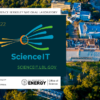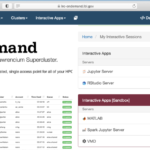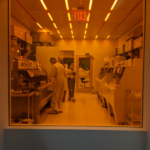THE SCIENCEIT PROGRAM WAS ESTABLISHED TO HELP SCIENTISTS FIND SOLUTIONS TO COMPUTING BARRIERS SO THEY CAN MOVE FORWARD IN THEIR RESEARCH. Berkeley Lab takes a science-centric approach to managing its Information Technology resources, recognizing that IT is intertwined with our scientific and … [Read more...] about ScienceIT Brochure 2022
ScienceIT
Workshop: Introduction to Open OnDemand on Lawrencium
Open OnDemand (OOD) is browser-based High Performance Computing (HPC) portal supported by NSF. OOD is the easiest way to access HPC resources in addition to the command line approach. The Scientific High Performance Computing group offers the Open OnDemand service for accessing Lawrencium and other … [Read more...] about Workshop: Introduction to Open OnDemand on Lawrencium
High-Performance Computing – on the Lawrencium Cluster at LBNL
Authors: Wei Feinstein, Shawfeng Dong, Gary Jung For almost 20 years, the IT Division’s Scientific Computing Group at Berkeley Lab, also known as HPCS (High-Performance Computing Services), has stood out as a national leader and pioneer in high-performance computing — essentially defining the … [Read more...] about High-Performance Computing – on the Lawrencium Cluster at LBNL
Cloud Computing Webinar, April 27, 11am-Noon
Join a Science IT webinar on Wednesday April 27th, 11:00am to 12:00pm to learn about the Lab’s Cloud Computing program and how cloud computing can benefit scientific research workflows. Jeff D'Ambrogia, Scientific IT Consultant, will share how to access the cloud program, what services are … [Read more...] about Cloud Computing Webinar, April 27, 11am-Noon
Autofocus for X-ray Crystallography: How AutoML Targets Samples at the ALS
Authors: Fengchen Liu, Jordan Jung, Shawfeng Dong, Tin Ho Published on February 10, 2022. Automated Machine Learning (AutoML) frameworks aim to automate tasks so non-experts can take advantage of machine learning on a large scale. There are a vast amount of these frameworks on the … [Read more...] about Autofocus for X-ray Crystallography: How AutoML Targets Samples at the ALS
Data Migration Project
The IT Division Data Migration Project celebrates an important milestone phase led by Collaboration Services. The Collaboration group is responsible for the administration and support of productivity applications and tools that help staff connect with colleagues and Berkeley Lab services, including … [Read more...] about Data Migration Project
Cloud Computing for Science at LBL
(Cloudy with a Chance of Science) Authors: Jeff D’Ambrogia, Fengchen Liu, Tin Ho, Shawfeng Dong, Gary Jung Published on January 7, 2022. Credit: Starecat.com In some respects, cloud computing has been around for so long that it seems old hat these days. Gone are the early days at … [Read more...] about Cloud Computing for Science at LBL
Open OnDemand is now available!
We are pleased to announce the release and support of Open OnDemand on the Lawrencium Supercluster. OnDemand provides a web-based approach for easy access to our HPC infrastructure. With OnDemand, you can upload and download files, create, edit, submit, and monitor jobs and connect via SSH, all via … [Read more...] about Open OnDemand is now available!
Open OnDemand Training Mar 10
Open OnDemand (OOD) is a browser-based High Performance Computing portal that provides an easy way to access HPC resources in addition to the conventional command line approach. The Scientific Computing Group now offers the Open OnDemand service for accessing Lawrencium and other dedicated research … [Read more...] about Open OnDemand Training Mar 10
Computing as a laboratory: How Molecular Foundry scientists model at the nanoscale
By Erica Yee • January 29, 2019 The Science IT Profiles series highlights how the Scientific Computing Group supports the work of Berkeley Lab researchers spanning various disciplines. In six of the seven facilities of the Molecular Foundry, scientists at benches or instruments, in lab … [Read more...] about Computing as a laboratory: How Molecular Foundry scientists model at the nanoscale
Was this page useful?











